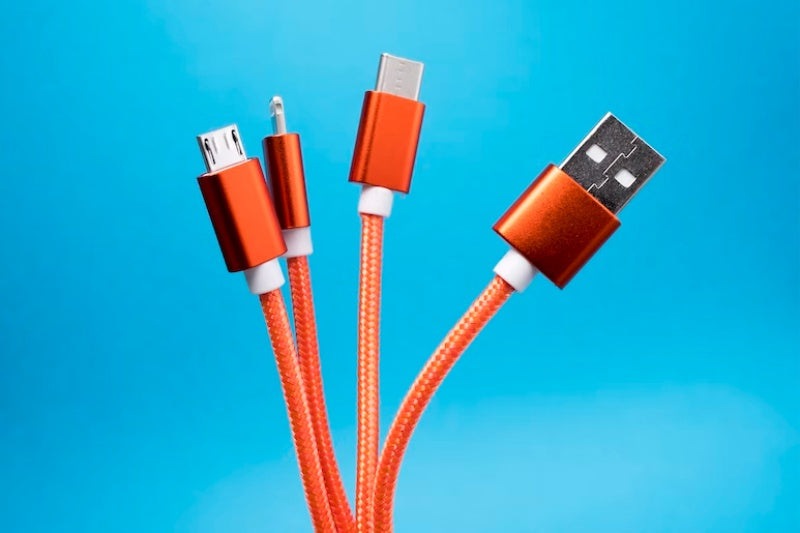What is the Lightning Connector?
The Lightning connector is a slight connection cable that charges and connects Apple's mobile devices (and some accessories) to computers and charging bricks.
The iPhone 5 and iPad 4 were released in 2012 and featured the Lightning connector. Although some devices, like the 2018 iPad Pro, might use USB-C instead of Lightning as its standard connector, it is still the most common way to charge them and connect them to other devices, such as a laptop.
The cable is compact and has a thin Lightning adapter and a USB-A adapter on either end. It doesn't matter which way the Lightning connector faces when plugged into the Lightning port because it is fully reversible and is 80% smaller than the 30-pin connector it replaced.

Lightning Connector Vs. USB-C: What is the Difference?
Spec
Each Lightning port measures 0.26 inches by 0.26 inches, making them smaller than USB-C ports. The USB-C port's protective cover measures 0.49 inches at the bottom and 0.33 inches at the top. The actual charging port is 0.26 inches tall, the same height as the Lightning.
USB-C ports transmit data at USB 3.0 speed, up to 640Mbps faster than Lightning ports, which only support USB 2.0 and transfer data at a rate of 480Mbps.
Although Apple hasn't released any official information, tech blog UGreen notes that USB-C cables have covers, unlike Lightning cables, which have exposed copper pins. According to reports, USB-C can withstand 10,000 plug-and-unplug cycles.
In terms of charging capabilities, the Lightning cable on the iPhone 13 supports 20W fast charging. That speed can charge your phone to 50% capacity in 30 minutes.
Meanwhile, the USB-C cable can support up to 240W of fast charging and is compatible with various fast charging options.
Cost
A certified Lightning cable with Apple's so-called "security chip" usually costs more than most other charging cables, including the USB Type-C cable. The chip inside every Lightning cable serves as an identifier, indicating whether or not the cable is certified. Of course, the chip is not free.
Those that are MFi certified are expected to be more expensive due to their higher quality level and Apple license. If you come across some extremely cheap Lightning cables, chances are they need to be certified. Does this imply that everything must be MFi certified? Perhaps not.
Simply put, a USB-C cable, MFi or not, is less expensive than a Lightning cable. But does this imply that you should use USB-C wires because they are less expensive, or should you avoid them because "you get what you pay for"?
Everything can be something other than this or that. So, forget about the price and talk about which one works better in its best form.
Reliability
Apple is the only company that uses the chip in the Lightning cable. According to Apple, its purpose is to ensure the safety and quality of the thread, which is an essential security requirement for any yarn, as well as to ensure compatibility between accessories and Apple devices. Is the chip making the line safer? Yes, compared to a non-MFi Lightning cable; however, this does not necessarily imply that it is more reliable than a USB-C cable.
A full-featured USB-C cable must include an E-Marker chip that uses CC (Configuration Channel) to identify and monitor data between USB devices, thereby controlling the power supply. It is critical to protect USB devices, especially when fast charging because it can help stabilize current and data transfer.
Because the USB-C connector must handle fast charging, it incorporates additional safeguards. A 3A (USB-C) cable has a higher internal resistance specification than a 2.4A (Lightning) cable. However, if you use any cable and charger within its full specification, you should be fine.
Lightning Connector Vs. USB-C: Which is Better?
Plugging in a USB-C cable is a wise choice in an imaginary phone with both ports. Not only can USB-C transfer data faster, but it can also transmit more power, allowing the phone to charge faster.
Due to Apple's tech ecosystem's isolation and the relatively low power requirements of its products, such as the iPhone or iPod, Lightning is an outdated standard that is still in use today. Powerful devices like the Macbook already make excellent use of USB-C.
Whether for valid reasons or not, Apple's refusal to upgrade the iPhone's charging ports has yet to win over many fans. Only time will tell whether the company will finally blink or abandon wired charging entirely.
